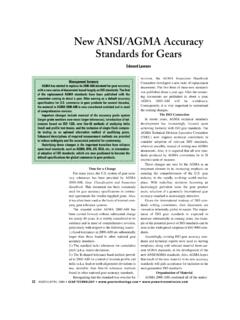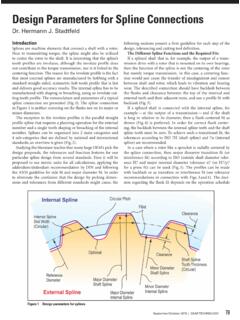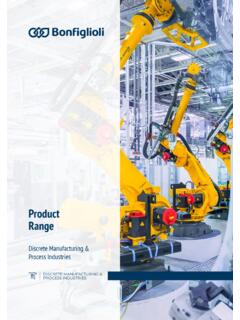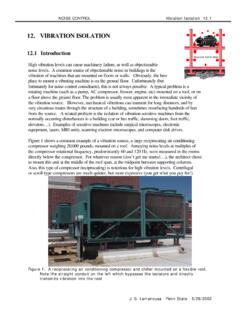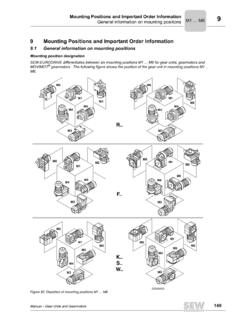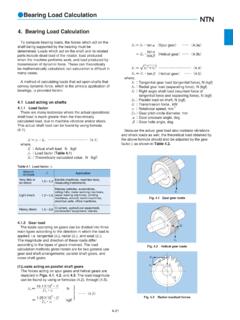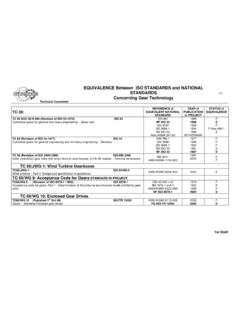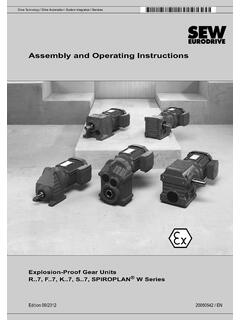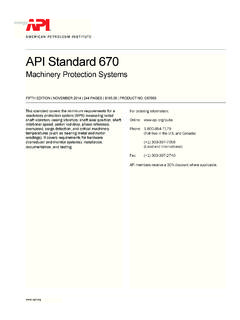Transcription of A Comparison of Current AGMA, ISO and API Gear Rating …
1 IntroductionThere are many different gear Rating methods in use today, and they can give substantially different results for any given gearset. This paper will make it easy to understand the choices and the impact the choices have on gearbox design. Eight standards are included AGMA 2001; AGMA 6011; AGMA 6013; ISO 6336; API 613; API 617; API 672; and API 677. A brief introduction and history of each standard is presented, and the basic differences between them are highlighted. Two sets of examples are used to illustrate the differences. These examples are presented in both tabular and graphical format, and are fully discussed. The first set contains a wide range of gears, and each gearset is rated by each standard. The second set compares gears designed for a specific set of requirements according to each of these standards.
2 The perils of increasing service factor are mentioned, particularly in regard to high pitch line velocity gears. Finally, there is a discussion of how to make a gearbox more reliable without changing the Rating method or service factor. The choice of Rating method can have a huge impact on the size of the gearbox, and this paper should help avoid specifying the wrong standard and having an oversized gearbox. It should also be useful as an aid to customers who are unsure of the differences between the of the StandardsAPI 613 5th edition (2003): Special Purpose gear Units for Petroleum, Chemical and Gas Industry Services. Most of the main gearboxes in refineries must conform to this specification. This is the most conservative standard, and if you specify this, you will probably pay substantially more for the gearbox than if another standard was specified.
3 This standard is for parallel shaft helical gear units that are in continuous service without installed spare equipment. The gears may be single or double helical , one or two stage, and may be designed as reducers or speed increasers, but it does not apply to integrally geared units such as integrally geared compressors (which are covered by API 617 and 672). Most of its requirements do not apply to general purpose gears since they fall under API 677; however, gear ratings calculated according to API 613 and API 677 are the same. API 613 covers not only gear Rating , but also the related lubricating systems, controls, and instrumentation. It was first published in 1968 based on AGMA formulas, but in 1977, the second edition was published with a very simplified approach.
4 It was designed so preliminary sizing of gearing could easily be done with just a slide rule. It does require the Geometry Factor J from AGMA 908, but before the age of computers, this was often estimated from graphs. This simple method is still the one used in API 613, even though slide rules are hard to find and engineers who know how to use them are becoming quite rare. The very conservative ratings stem mainly from basing the material allowable stresses on the lowest grade materials (grade 1) from the AGMA standard in effect in 1977, even though use of the better grade 2 materials is required. Although AGMA allowable stresses have increased over the years to reflect increasingly stricter metallurgical requirements, improved metallurgy, and extensive field experience, the API ratings have remained unchanged.
5 The sixth edition is currently in development and may be published this year (2018). It appears that the Rating equations will change to mirror those in AGMA 2001, but there will be a derating factor introduced so the resulting ratings may be similar to those of the prior editions. However, it does incorporate language to allow the use of alternate Rating methods if the API method would result in excessive pitch line velocity or excessive face 617 8th Edition (2014): Axial and Centrifugal Compressors and Expander-Compressors; Part 3 Integrally Geared Centrifugal Compressors. This was first published in 1958 and covered only barrel-type centrifugal compressors, since inte-grally geared centrifugal compres-sors did not exist at that time.
6 The 2002 seventh edition expanded the scope to cover Integrally Geared Centrifugal Compressors and Expander-compressors. It is now essentially three standards pack-aged as one. Each section has its own set of annexes, and for integrally geared cen-trifugal compressors, an annex in part 3 specifies a Rating method based directly on ANSI/AGMA 2001. This method specifies how each factor is to be calcu-lated, and then imposes an additional 20% derating factor. So, it is quite con-servative, but not nearly as conservative as API 613. The eighth edition of API 617 was published in 2014 and did not change this Rating 2001-D04 (2004): Fundamental Rating Factors and Calculation Methods for Involute Spur and helical gear Teeth. AGMA 2001 and 2101 (the metric version) are the basic AGMA gear Rating standards that most other AGMA Rating standards are based on, and they have evolved from standards originally published in 1946.
7 The ratings calculated by these standards have slowly risen over the years as a result of higher allowable stress numbers that have been introduced along with stricter metallurgi-cal requirements. The user is given some flexibility in selecting the values of the factors to be used in the Rating , so even given complete information on a gearset, A Comparison of Current AGMA, ISO and API gear Rating MethodsJohn M. RinaldoPrinted with permission of the copyright holder, the American gear Manufacturers Association, 1001 N. Fairfax Street, Fifth Floor, Alexandria, VA 22314-1587. Statements presented in this paper are those of the author(s) and may not represent the position or opinion of the American gear Manufacturers TECHNOLOGY | July 2018[ ]technicaltwo engineers may use different values for some factors and come up with differ-ent ratings using this standard.
8 Therefore, specific application standards such as API 617 part 3, AGMA 6011, or AGMA 6013, provide guidance on selecting the fac-tors to be used in the Rating . The AGMA helical gear Rating Committee has been working for many years to revise this standard, but it may be a while before a new revision is 6013-B16 (2016): Standard for Industrial Enclosed gear Drives. This standard is for low- to mod-erate-speed gears. This, and its metric version AGMA 6113-B16, is a combi-nation of prior standards ANSI/AGMA 6009-A00 and ANSI/AGMA 6010-F97 which in turn were based on AGMA 480, AGMA 460, and AGMA 420. It presents general guidelines for design, Rating , and lubrication of parallel, concentric, and right-angle shaft drives. However, this paper will only consider the Rating of parallel shaft gearboxes.
9 For these gearboxes, this standard only applies when the pitch line velocity does not exceed 7,000 ft/min ( m/s). It specifies that ANSI/AGMA 2001-D04 is to be used for the Rating , and provides the specific factors to be used. The Rating is for 10,000 operating hours, using the least conservative life 6011-J14 (2014): Specification for High-Speed helical gear Units. The first high-speed gear unit standard was adopted in 1943 and has evolved over time. It is now based on ANSI/AGMA 2001-D04 and applies when the pitch line velocity exceeds 6,890 ft/min (35 m/s). The factors to be used for Rating are either specified or a specific calculation procedure is given. The Rating is for a minimum of 40,000 operating hours, using the most conser-vative stress cycle (life) factor.
10 However, if the number of stress cycles exceeds the stress cycle factor graph endpoint, then the designer has the option of using the graph endpoint or extrapolating the curve to lower 6336-2006 (with the exception of part 5, released in 2003): Calculation of Load Capacity of Spur and helical Gears. This standard, which is composed of five separate parts, is largely based on prior DIN standards and is generally accepted everywhere outside of the United States. It contains multiple methods to establish ratings, including method A (testing the gears under simulated or actual operating conditions) and various calculation methods. In general, method B should be used. There are a number of fundamental differences between the AGMA and ISO Rating methods.


